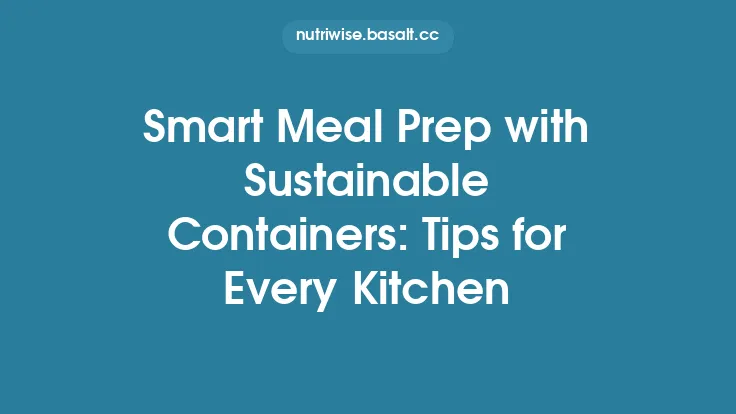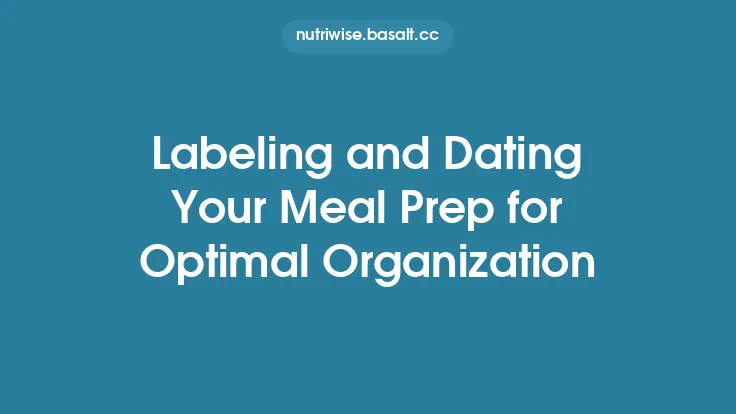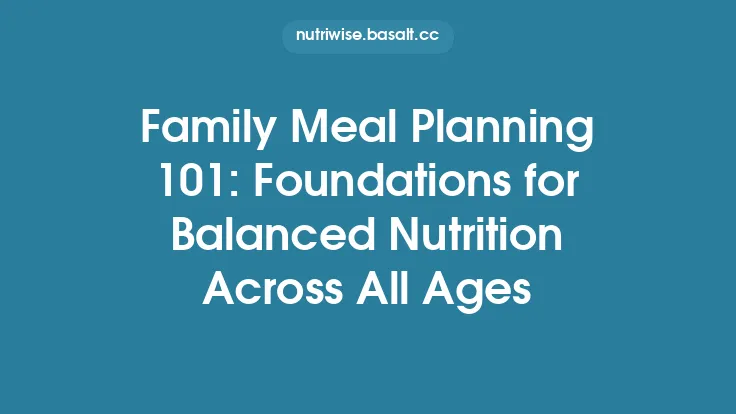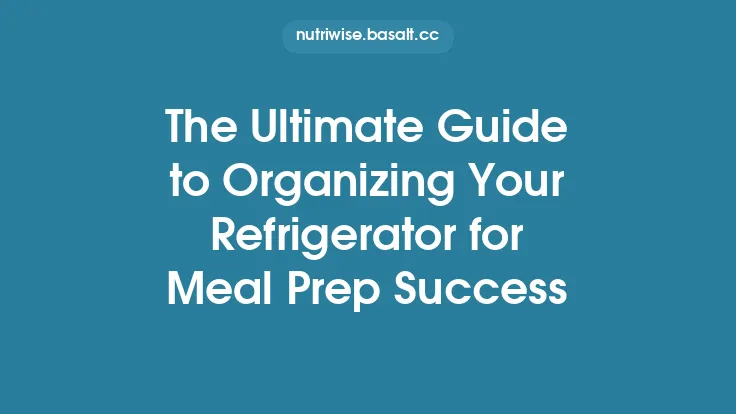Meal preparation can be a game‑changer for busy lifestyles, but the convenience it offers comes with a responsibility: keeping the food you prepare safe to eat. Even a small lapse in hygiene or temperature control can turn a nutritious, ready‑to‑go meal into a breeding ground for harmful bacteria, viruses, or parasites. Below is a comprehensive guide to the essential safety practices that protect you and your family from foodborne illness while you plan, cook, and store meals for the week ahead.
Understanding Foodborne Pathogens
Foodborne illness is most often caused by microorganisms that multiply under the right conditions. The three categories you’ll encounter most frequently in a home kitchen are:
| Pathogen | Typical Source | Growth Conditions | Illness Symptoms |
|---|---|---|---|
| Salmonella | Raw poultry, eggs, unpasteurized dairy | 5 °C–45 °C (41 °F–113 °F) | Diarrhea, fever, abdominal cramps |
| Staphylococcus aureus | Improperly handled cooked foods, skin flora | 7 °C–48 °C (45 °F–118 °F) – produces heat‑stable toxin | Nausea, vomiting, rapid onset |
| Clostridium perfringens | Cooked meats left at room temperature | 12 °C–55 °C (54 °F–131 °F) – spores survive cooking | Abdominal cramps, watery diarrhea |
Other notable culprits include *Listeria monocytogenes (often linked to ready‑to‑eat deli items) and Bacillus cereus* (found in rice and starchy foods). Understanding where these organisms originate helps you target the most critical control points in your meal‑prep workflow.
Personal Hygiene Practices
Your hands are the most common vehicle for transferring pathogens onto food. Adopt these habits every time you enter the kitchen:
- Handwashing Protocol
- Wet hands with warm water, apply soap, and scrub for at least 20 seconds (including backs of hands, between fingers, and under nails).
- Rinse thoroughly and dry with a single‑use paper towel or a clean, lint‑free cloth.
- Use the paper towel to turn off the faucet to avoid re‑contamination.
- Glove Use
- Disposable gloves can be useful when handling ready‑to‑eat foods, but they are not a substitute for handwashing. Change gloves after each task (e.g., after touching raw meat) and discard them promptly.
- Personal Cleanliness
- Keep hair restrained (hairnet or tied back) to prevent stray strands from falling into food.
- Avoid wearing jewelry that can harbor bacteria in crevices.
- If you are ill, especially with gastrointestinal symptoms, refrain from food preparation until fully recovered.
Sanitizing Work Surfaces and Equipment
A clean workspace is the foundation of safe meal prep. Follow a two‑step process for every surface and utensil:
- Cleaning – Remove visible debris with hot, soapy water.
- Sanitizing – Apply a solution that achieves a minimum of 100 ppm (parts per million) free chlorine (e.g., a diluted bleach solution of 1 tablespoon unscented bleach per gallon of water) or use a commercial kitchen sanitizer that meets EPA standards. Let the surface remain wet for the contact time specified on the product label (usually 1–2 minutes) before wiping dry.
Cutting Boards:
- Use separate boards for raw proteins, fresh produce, and ready‑to‑eat items.
- Plastic boards can be sanitized in the dishwasher (high‑heat cycle).
- Wooden boards should be cleaned with hot, soapy water, then sanitized with a vinegar solution (1 part white vinegar to 4 parts water) and allowed to air‑dry.
Sponges and Dishcloths:
- Replace sponges every 1–2 weeks.
- Microwave a damp sponge for 2 minutes to kill bacteria (ensure the sponge is microwave‑safe).
- Dishcloths should be laundered in hot water (≥ 60 °C / 140 °F) after each use.
Preventing Cross‑Contamination
Cross‑contamination occurs when pathogens move from a contaminated source to a safe food item. Mitigate this risk with the following strategies:
- Separate Storage: Store raw meat, poultry, and seafood on the lowest shelf of the refrigerator in sealed containers to prevent drips onto other foods.
- Dedicated Utensils: Assign specific knives, tongs, and spoons for raw and cooked foods.
- Color‑Coding System: Use a simple color code (e.g., red for raw meat, green for vegetables, yellow for cooked foods) to quickly identify the correct tools.
- Avoid Re‑use of Marinades: If a marinade has been in contact with raw protein, discard it or bring it to a boil for at least 1 minute before using as a sauce.
Cooking to Safe Internal Temperatures
Heat is the most reliable method for destroying harmful microorganisms. Use a calibrated food‑grade thermometer to verify that each protein reaches its recommended internal temperature:
| Food Type | Minimum Internal Temperature |
|---|---|
| Poultry (whole, parts, ground) | 165 °F (74 °C) |
| Ground meats (beef, pork, lamb, veal) | 160 °F (71 °C) |
| Beef, pork, lamb, veal (steaks, roasts, chops) | 145 °F (63 °C) + 3‑minute rest |
| Fish & shellfish | 145 °F (63 °C) |
| Egg dishes (quiches, casseroles) | 160 °F (71 °C) |
| Leftovers & reheated foods | 165 °F (74 °C) |
Thermometer Tips:
- Insert the probe into the thickest part of the food, avoiding bone or fat.
- For thin items (e.g., burgers), insert the probe from the side to reach the center.
- Calibrate your thermometer monthly by placing it in ice water (should read 32 °F/0 °C) and boiling water (should read 212 °F/100 °C at sea level).
Rapid Cooling and Proper Storage
Even after cooking, food can become unsafe if it lingers in the “danger zone” (40 °F–140 °F / 4 °C–60 °C) for too long. Follow the 2‑hour rule: food should not remain at room temperature for more than 2 hours total (1 hour if ambient temperature exceeds 90 °F/32 °C). To achieve rapid cooling:
- Divide Large Portions – Spread cooked food into shallow containers (no deeper than 2 inches) to increase surface area.
- Ice‑Water Bath – Place the container in a larger bowl filled with ice and water, stirring occasionally to release heat.
- Stirring – For soups or stews, stir frequently to disperse heat evenly.
- Refrigerate Promptly – Once the food’s temperature drops to 70 °F (21 °C) or lower, transfer it to the refrigerator.
Refrigerator Placement: Store prepared meals on the middle shelves where temperature is most consistent, and keep the door closed as much as possible to maintain a stable environment.
Safe Thawing Techniques
Thawing frozen ingredients improperly can allow surface bacteria to multiply while the interior remains frozen. Use one of these safe methods:
- Refrigerator Thawing: Transfer the item to a tray on the bottom shelf and allow it to thaw gradually (usually 12–24 hours depending on size).
- Cold‑Water Thawing: Submerge the sealed package in cold water, changing the water every 30 minutes. Cook immediately after thawing.
- Microwave Thawing: Use the defrost setting, but cook the food right away because microwave heating can create hot spots where bacteria survive.
Never thaw foods at room temperature on the countertop.
Managing Leftovers and Reheating Safely
Leftovers are a staple of meal prep, but they must be handled correctly to stay safe:
- Time Limit: Consume refrigerated leftovers within 3–4 days.
- Reheat to 165 °F (74 °C): Use a thermometer to confirm the internal temperature throughout the dish.
- Stir During Reheating: For soups, stews, or casseroles, stir halfway through heating to eliminate cold pockets.
- Avoid Re‑Repeated Heating: Reheat only once; repeated cooling and reheating increase the risk of bacterial growth.
Implementing a Food Safety Checklist
A simple, printable checklist can embed safe habits into your routine. Include items such as:
- [ ] Hands washed for 20 seconds before starting.
- [ ] Cutting boards color‑coded and sanitized after each use.
- [ ] Thermometer calibrated and used for all proteins.
- [ ] Cooked foods cooled to ≤ 70 °F within 2 hours.
- [ ] Containers labeled with preparation date (optional for organization).
- [ ] Refrigerator temperature set below 40 °F (4 °C).
- [ ] Leftovers stored in shallow containers and consumed within 4 days.
Review the checklist at the start and end of each meal‑prep session to reinforce compliance.
Training and Ongoing Vigilance
If you share kitchen duties with family members, roommates, or coworkers, ensure everyone understands these safety principles:
- Conduct a brief “food safety briefing” before each batch‑cooking day.
- Encourage questions and discuss any recent food‑borne illness alerts from reputable sources (e.g., CDC, FDA).
- Periodically audit the kitchen for compliance—check that sponges are fresh, sanitizing solutions are correctly mixed, and thermometers are functional.
Continuous education and a culture of accountability are the most effective defenses against foodborne illness.
By integrating these essential safety practices into every step of your meal‑prep workflow—from handwashing to rapid cooling—you dramatically reduce the risk of contamination and protect the health of everyone who enjoys your meals. Consistency is key: the habits you build today will keep your kitchen safe and your meals delicious for years to come.





